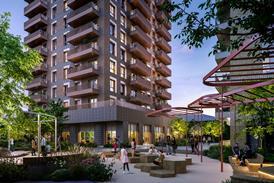Achieving the UK’s housing and net zero goals demands inclusive community engagement and innovative, cooperative planning, not divisive rhetoric, writes Ed Houghton

As the political parties set out their election policies, we’re hearing a lot about “building on the greybelt” and “pushing” housing development through planning. The UK desperately needs affordable new homes at scale – the country is missing its target by 100,000 a year according to the Home Builders Federation – and there need to be bold, creative approaches to deliver them. But the rhetoric and reporting around this often sets it up as a battle, as a “war on NIMBYs”. This language is far from useful.
To achieve net zero, things have to change rapidly - buildings, transport, behaviours, energy, and the way we heat and insulate our homes. We also need to look to new technologies and ways of doing things. People must have a voice in how their communities grow and are shaped through development – they are important stakeholders that developers and government must engage with. At its most effective, consultation and engagement can positively enhance planning to meet local needs.
But over time, these important democratic processes have too often been shaped by a politics of division and a mindset based on lack of trust, leading to suspicion of the new, and then a reaction against potentially useful, positive advances. We don’t believe this cycle should just be seen as the fault of local people, but rather a failure of politics to engage, communicate, inform and demonstrate the value of a new proposition. This is something that we can work to counter through listening, research to understand people’s barriers, and active engagement.
Community engagement can’t be seen as simply a hurdle to getting planning through or implementing a new service, it’s the backbone of successful transformation. Historically, this has been done in the town hall, in meetings and with surveys, but these are increasingly limited in their impact as they only reach those who are already to some extent engaged. To truly bridge the gap, councils and developers need innovative approaches that encourage active participation from all members of the community, and must have the intent to understand and value the views of people in their work.
Again, we read a lot about co-design, and the need to do it right, to ensure wide participation. As an organisation that runs public workshops across a broad range of topics, we know that an overlooked issue when it comes to ensuring this is the challenge of recruitment. It isn’t possible to design the people sitting around a table, you can only create the conditions that invite broad participation and work to raise awareness of the importance of getting involved. Still, sometimes, it can be hard to persuade the public to give their time to the co-design process. Positioning NIMBY vs YIMBY as a battle can only make this harder and positions more entrenched.
If resistance is persuasive, is the solution really such a good one?
Delivered well, co-design workshops provide an important platform for people’s views to be heard. They can foster a sense of ownership and empowerment among those that take part, who are then more likely to support and even advocate for a project. It was interesting to read coverage of the new Phoenix housing development in Lewes in the press – such was the effectiveness of engagement that 100 people came out to protest in favour of the plans at County Hall.
There is a burgeoning YIMBY movement, particularly among the young – those most disenfranchised and affected by the housing crisis. We don’t stereotype in our research, and it can throw up surprising findings – in the case of self-driving cars, for example, we found younger people were most open to the prospect, but that interest picks up again among those in later life. If the appetite for change and innovation is there, let’s have a conversation on what it looks like, not a war.
Effective community engagement demands a multidisciplinary approach, as it brings in various disciplines, not least design, planning, technology, communications and psychology. Local authorities play a central role in coordinating efforts, but they also need to bring in specialist expertise and train their own teams – this outlay can have wider benefits in terms of relationships, and can pay real dividends when it comes to implementing any new innovation intended to save time, money and energy.
When we advise organisations on best practice, there are four key principles we advocate: prioritise inclusivity, invest in education, be transparent and impartial in putting forward any tech or suppliers, and continuously evaluate and adapt engagement strategies based on feedback. Essentially, don’t treat the public as passive participants in an intended outcome, but as a critical filter for an idea. If resistance is persuasive, is the solution really such a good one?
Of all the institutional actors available to move people to a more YIMBY way of thinking, the local authority is probably best placed to make it happen. With today’s pressures on councils, the budget for the kind of engagement needed may be hard to find. If local authorities were better funded in this area, we might see less resistance to technologies that could contribute to national net zero priorities, more open lines of communication around controversial transport policies and the new housebuilding that politicians want to be able to promise.
Postscript
Ed Houghton is director of research and insights at DG Cities, a Greenwich-based consultancy working on housing decarbonisation, tech innovation, strategy, engagement and research.
















2 Readers' comments